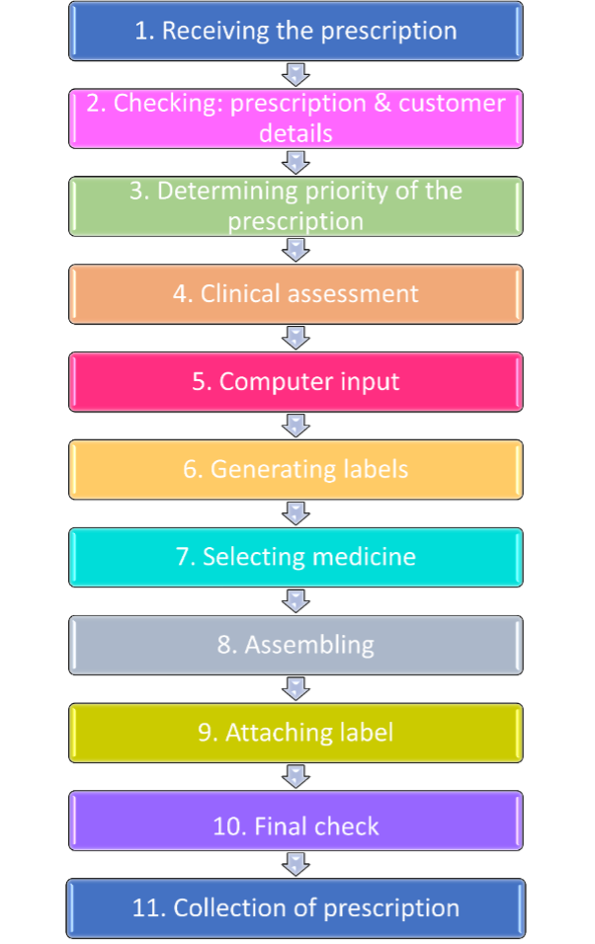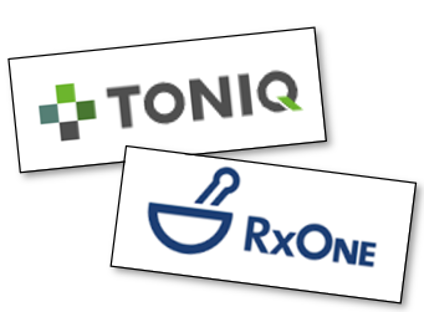This week, we will look at managing stock and inventory, dispensing software, and pathogens and infectious diseases.

Professionalism and Support
As you know, part of the role of the pharmacy technician is to manage dispensary stock. Let’s review what stock management means in the pharmacy context.
The pharmacy business
A pharmacy, like any other business, must make a profit. This means the income (money coming into the business) needs to be greater than the expenses (money going out of the business). A pharmacy must purchase, manage, and sell stock in order to earn income in such a way that they make a profit.
Stock and Inventory
In business terms, the words stock and inventory are similar.
Is it stock or is it inventory?
Use your research skills and find out the definition of these two words and how they differ. Once you have found the answer yourself, compare your answer to the one below.
Stock refers to the goods or products that a business holds for sale or distribution. It specifically refers to the items that are intended for resale or use in the normal course of business. Stock can include finished goods, merchandise, or items held in a warehouse or retail store awaiting sale or shipment.
Inventory is a broader term that encompasses all the goods and materials a business holds, including stock. It includes raw materials and work-in-progress items.
Inventory management
Inventory management encompasses the management of both stock and other types of inventory within a business.
We’ve gathered some key business concepts you should know. Try your hand at matching up terms to their meaning. If you don’t know them all, be sure to check the solution before moving on and taking note of new terminology. Progress through all four questions using the navigation beneath the questions.
Stock management
Stock management in pharmacy is the function of understanding the stock mix and the different demands for that stock mix. A key decision is how much inventory to keep on hand. Inventory is usually a pharmacy’s largest asset.
Once inventory levels are established, they become an important input to the financial aspect of any business, as they are key to driving cash flow and profitability. Good stock control practices require a good knowledge of the medicine and OTC requirements of the pharmacy. Too much stock leads to too little cash and, often, to less profitability. But too little inventory can mean lost sales as customers go to another pharmacy to fill their prescriptions or purchase their products.
There are many aspects to consider when managing inventory. In general, stock ordering should be done by a person who has a working knowledge of supply and demand.
It involves a fine balance between:
| Ordering costs | Costs associated with:
|
|---|---|
| Holding costs | Costs associated with holding and storing stock over a period of time. Sometimes referred to as carrying costs. |
| Storage costs | Costs associated with the safe and secure storage of the optimal amount of stock. A loss is incurred when stock is unavailable. If stock is not managed properly, demand for a product exceeds what the pharmacy can supply, resulting in lost sales, dissatisfied customers, and potential damage to the business's reputation. |
Business terms review
The explanation of storage costs above includes the terms supply and demand. The next two-question activity will give you a chance to ensure you know what they mean.
| Stock turn | Stock turn calculations help us determine how much and how often we need to order stock. |
|---|---|
| Stock on hand (SOH) | The amount of medicine in the pharmacy. |
To understand how to calculate stock turn and what quantities to order to manage stock effectively, read through this scenario then and fill in the blanks.
Lisa is a pharmacy technician. Today Lisa is involved in stock orders. The pharmacist asks her to ensure the pharmacy has enough sunscreen to meet the demand for the next 15 days. He tells her that, on average, the pharmacy sells 5 bottles of sunscreen per day.
The pharmacist was impressed with Lisa’s work and asked her to continue ordering. Answer the next four questions to complete Lisa's tasks.
In general, a high stock turn or turnover indicates that inventory is being sold and replenished rapidly. This is good for the pharmacy business as it reduces holding costs and the risk of stock expiring.
A low stock turn (turnover) indicates slower inventory movement. This is not good for the pharmacy business as there are increased holding costs and the risk of stock expiring before it is sold and used. Low stock turnover can mean that there is a problem with stock management, such as over-ordering or issues with stock counting.
What do you think the pharmacy can do to manage its stock effectively? Jot down some notes, and when you have an answer, expand the label below to see if you are on the right track.
Place fewer orders
- Many pharmacy owners today still place several small orders throughout the day. They scan their shelves at the end of the day and place a final order before locking up in the evening. However, when you place larger orders fewer times throughout the week, you spend less time preparing orders and putting orders away, which can ultimately save you money.
Reduce overall stock holding
- Get rid of excess stock, outdated products, and items that are on the shelves but rarely or never move. This decrease in inventory can increase cash flow. This increased cash flow also means you can pay your suppliers faster and earn even more savings on the cost of goods.
Invest in a better stock control system
- By investing in a computer system that has inventory management capabilities, you can offset the expense of the new equipment with the savings you’ll see in other areas of your business. For example, your payroll expenses will likely decrease because you’ll improve your ordering patterns and reduce the hours worked by your staff.

Good planning helps
Stop “just-in-time” ordering
- Just-in-time ordering means coordinating ordering and delivery exactly when products are needed. This type of ordering aims to reduce excess inventory, storage costs, and waste by closely synchronizing supply with demand, resulting in a more efficient and streamlined supply chain.
- It does carry the risk that the pharmacy can’t get the products they need if the provider has supply or delivery issues. This results in not being available when needed. Also, it requires the pharmacy to be accurate in forecasting what their demand for products is, and if there are any changes to demand, they might end up over or under-ordering.
A good plan for ordering stock includes:
- Identify minimum levels of each item
- Identify items that are below minimum levels and need re-ordering
- Check for the cheapest source – are specials or discounts being offered?
- Check if items are currently more expensive – can ordering wait until there is a discount or prices drop?
- Consider delivery rates – daily, weekly, monthly, overnight which rate is less expensive?
- Calculate quantities required
- Consider the timing of orders (1st of the month).
Self-directed learning activities
Journal post – Workplace Investigation
Find out the following information and record your answers in a journal post.
In your workplace:
- Who is responsible for stock management?
- Is there one main person or several?
- What are your pharmacy's Standard Operating Procedures (SOPs) for ordering and stock management?
- What systems or technology is used for ordering and managing stock?
- Where can you go to find out information about stock turn and daily averages of sales for specific items?
- What OTC product has the highest turnover?
- Is this different for different times of the year?
- Why might this product be the highest seller?
- What OTC item has the lowest turnover?
- Is this different for different times of the year?
- Why might this product be the lowest seller?
Excellent! Another week of Professional Practice 1 is complete.

Previously, we looked at the following 11 steps in the dispensing process. As we have already noted, this is just one way we can view the dispensing process. Each pharmacy will have its own SOPs, including the following dispensing procedures and processes.
Take a moment now to look at each step and challenge yourself to remember what a pharmacy technician does in each step. You might like to make yourself some notes on a piece of paper to check your learning.

Dispensary software

Throughout the dispensing process, you will need to use dispensary software for various activities, such as verifying patient history, searching for medication details, and inputting information into the system. You may already be familiar with the software, but it is worth taking some time now to get an overview of the two main pharmacy management systems.
These are:
- Toniq - https://toniq.nz/
- RxOne - https://www.rxone.co.nz/
Learn more about these two management systems on your own and answer the following questions. Don’t limit your search to the company websites, do some wider searching!
Record your answers in your journal and publish your post.
- Where were the Toniq and RxOne management systems created?
- Describe the software functions that each system is comprised of.
- What pharmacy activities can they be used for?
- Can you find any video tutorials to help you learn about these systems either on their websites, YouTube, or other sites? If so, create a list of useful links for later use and to help others looking at your journal post.
- What has been your experience so far in using pharmacy software?
- What functions have you used?
- Do you feel confident using these functions?
- What have been your successes and challenges when using the pharmacy software?
- Have you had experience using the dispensing software in a pharmacy workplace?
- What do you think might be some potential issues a pharmacy technician might experience when using dispensing software?
Prescription entry
When you are entering a prescription for an existing customer, you need to search for their records in the system. The steps you take to do this will depend on the software system your pharmacy uses.
Resources:
- Toniq Dispensary Beginners Guide
- NZMA Introduction to Toniq
- RxOne Dispensary Manual
- 2019 RxOne Student Tutorial: YouTube
Using the resources above (and any others), find out the steps or methods you can take in Toniq and in RxOne for:
- Entering a prescription for an existing patient
- Creating a new patient in the system so that you can enter their prescription.
Describe these steps or methods in your journal and publish them. Did others find different steps to yours?
If you have difficulty with any of these activities, check in with your tutor.
Self-directed learning activities
Complete the following tasks:
Task 1
Answer the following four questions:
Task 2
Spend the rest of your self-directed learning time reviewing the dispensing process and finalising your dispensing process checklist for task 2, Assessment 02A1.

Pathogens
In this section of learning, we will shift our attention from health conditions and pharmacy treatments to explore the fascinating field of microbiology. Our focus will be on studying pathogens, infections, and anti-infective therapy.
Use this activity to test your knowledge of medical terms. Be sure to check the solution and note any new terms before continuing.
Challenge yourself to think of a disease or illness caused by each of these types of pathogens before expanding the label of each one to learn more. You may be surprised at how much you already know!
Not all bacteria cause infections. Those that can are called pathogenic bacteria. Examples of illness caused by bacteria are strep. throat, tuberculosis, and food poisoning.
Chicken pox is an example of an illness caused by a virus as well as measles, mumps, and influenza.
Fungi can cause an infection when their normal levels in the body go into over-growth. They result in illnesses such as athletes’ foot or vaginal thrush.
Parasites are organisms that behave like tiny animals, living in or on a host and feeding from or at the expense of the host. Examples of parasites are head lice and intestinal worms.
It’s important to understand what factors contribute to the growth and reproduction of pathogens. The following is a list of those factors. Expand each label to learn more.
Different pathogens have different temperature preferences. Most human pathogens' optimal temperature for growth is the same as the human body temperature, which is around 37 degrees Celsius. Other pathogens prefer much colder or much hotter temperatures.
Example: Neisseria meningitidis
This bacteria is the cause of meningococcal meningitis. It thrives in the human body, particularly in the upper respiratory tract, where the temperature is around 37 degrees Celsius.
Light is generally not a critical factor for the growth and reproduction of most pathogens. In fact, many pathogens prefer darkness and can even be harmed by exposure to ultraviolet (UV) light. However, some pathogens, especially those that cause skin infections or certain fungal infections, may have specific light requirements or sensitivities.
Example: Dermatophytes
This is a fungus that causes skin infections such as athlete's foot and ringworm. They prefer darkness and are commonly found in warm and humid environments like shoes, socks, and moist areas of the body.
The acidity or alkalinity of the environment, measured on the pH scale, can significantly affect the growth of pathogens. Different pathogens have different pH preferences. Most pathogens that affect humans thrive and grow best in a neutral pH, which happens to be the pH of our blood and inside our tissues, hence the growth of microbes leading to infection.
Example: Helicobacter pylori
This bacterium colonises the stomach and can cause peptic ulcers and gastritis. It can withstand the acidic conditions of the stomach, with an optimal pH range of 2 to 4.
The presence or absence of oxygen in the environment can impact the growth and reproduction of pathogens. Some pathogens are aerobic and require oxygen to survive, while others are anaerobic and can only grow in the absence of oxygen. Other pathogens are facultative anaerobes. This means they can adapt to both oxygen-rich and oxygen-poor environments.
Example: Clostridium tetani
The bacteria is responsible for tetanus infection. It prefers anaerobic conditions. It can grow in deep wounds or puncture sites with limited oxygen supply.
Pathogens require specific nutrients to grow and reproduce. These nutrients include carbohydrates, proteins, fats, vitamins, and minerals. Different pathogens have different nutrient requirements, and the availability of these nutrients in the environment can influence their growth. For example, some bacteria can utilize a wide range of nutrients, while others have specific requirements.
Example: Mycobacterium tuberculosis.
The bacterium causing tuberculosis (TB) requires specific nutrients, particularly iron, for its growth. It can manipulate the host immune system to access and acquire iron, which is essential for its survival and replication.
The free flow of water is vital to microorganisms for their cells to exchange materials and for their metabolic processes. As a general rule, though, the more moisture, the more microorganisms there will be found.
Example: Legionella pneumophila
This bacterium is responsible for causing Legionnaires' disease, a severe form of pneumonia. It thrives in water environments such as hot water systems, air conditioning systems, and water reservoirs, where it can grow and multiply.
Infectious diseases
Now that we have explored some basic microbiology concepts, we are moving on to look at how infectious diseases are transmitted and controlled.
Watch: The basics of controlling infectious diseases (5:20 minutes)
Watch this interactive video to give you an overview, and then answer the six questions that follow to help you retain the content.
Journal Post
The video discussed direct and indirect modes of disease transmission. These modes can be separated further.
In a new journal post, give a 1-2 sentence explanation of each of these modes:
Direct:
- In the air as droplets or aerosol particles
- Faecal-oral spread
- Blood or other body fluids
- Skin or mucous membrane contact
- Sexual contact.
Indirect
- Contaminated food or water
- Contaminated environment
- Vector-born.
Don’t forget to publish it and take a look at the responses of your peers.
Self-directed learning activities
The spread of pathogens can be reduced by maintaining good hygiene. Not everyone understands what is meant by ‘good hygiene.’ As a pharmacy technician, you will be providing advice and counselling on what good hygiene looks like to help people not only protect themselves from getting an infectious disease but also about how to prevent any disease they have from spreading to others.
Hygiene can be classified into two broad categories:
- Personal hygiene
- Environmental hygiene.
Download this template on personal and environmental hygiene practices. Carry out your own research, complete the table, and upload it to your journal.
Well done, you've completed Week 11!
